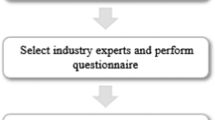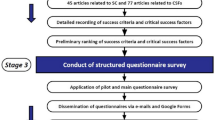Abstract
The implementation of a management by deliverables and deadlines is based on detailed planning and strict control of deliverables. It is a strategic decision that reports to the project manager and a key element to the success of complex projects. Based on the modeling of the project elements and their interactions using weighted directed graphs, this article presents some contributions to anticipate potential behavior of the project. Topological and propagation analyses are made to detect and prioritize critical elements and critical interdependencies while enlarging the sense of the polysemous word “critical.” We recommend a set of topological indicators suitable for project elements and interactions, which mainly allow us to discuss “How the impact of a project element affects other elements within the network? What is the collective influence of this element?”. These indicators permit to prioritize project elements and their interactions by detecting the most influential ones taking into account the network structure. For instance, they permit to evaluate the collective criticality of project deliverables and to re-evaluate the priority of the risks associated with these deliverables by coupling the traditional features of individual risks with the topological indicators of the deliverables. Furthermore, some algorithms are applied to extract and visualize the propagation path between two elements within the network. For example, this allows to provide a vision of potential impact propagation between two project deliverables, either they are associated with two milestones or are critical. An application to automotive industry illustrates the benefits of the approach, and some perspectives are drawn for further work.









[adapted from (Marle and Vidal 2016)]









Similar content being viewed by others
References
Akao Y (1990) Quality function deployment. Productivity Press, Cambridge
Association of Project Management (2000) Syllabus for the APMP Examination (2nd Ed) Appendix 1 Glossary of Project Management Terms., Association of Project Management. ed. High Wycombe, UK
Barry W, Leite F, O’Brien WJ (2015) Late deliverable risk catalog: evaluating the impacts and risks of late deliverables to construction sites. J Constr Eng Manag 141:04014087. doi:10.1061/(ASCE)CO.1943-7862.0000950
Bonacich P (1972) Factoring and weighting approaches to status scores and clique identification. J Math Sociol 2:113–120
Borgatti SP (2005) Centrality and network flow. Social Networks 27:55–71
Borgatti SP, Everett MG, Johnson JC (2013) Analyzing social networks, 1st Edition. ed. SAGE Publications Limited
Braha D, Bar-Yam Y (2004) Information flow structure in large-scale product development organizational networks. J Inf Technol 19:244–253
Braha D, Bar-Yam Y (2007) The statistical mechanics of complex product development: empirical and analytical results. Manage Sci 53:1127–1145
Browning TR (2001) Applying the design structure matrix to system decomposition and integration problems: a review and new directions. IEEE Trans Eng Manage 48:292–306. doi:10.1109/17.946528
Browning TR (2014) Managing complex project process models with a process architecture framework. Int J Project Manage 32(2):229–241
Browning TR, Ramasesh RV (2009) A survey of activity network-based process models for managing product development projects. Production and operations. Management 16:217–240. doi:10.1111/j.1937-5956.2007.tb00177.x
Bruni ME (2011) A heuristic approach for resource constrained project scheduling with uncertain activity durations. Comput Oper Res 38:1305–1318
Bryde DJ, Joby R (2007) Product-based planning: the importance of project and project management deliverables in the management of clinical trials. R&D. Management 37:363–377
Cano JL, Lidón I (2011) Guided reflection on project definition. Int J Project Manag 29:525–536
Clarkson PJ, Simons C, Eckert C (2004) Predicting change propagation in complex design. J Mech Des 126:788
Cook RI (1998) How complex systems fail. Cognitive Technologies Laboratory. University of Chicago, Chicago
Danilovic M, Browning, TRTR (2007) Managing complex product development projects with Design structure matrices and domain mapping matrices. Int J Project Manage 25:300–314
Dijkstra EW (1959) A note on two problems in connexion with graphs. Numerische mathematik 1:269–271
Eppinger SD, Browning TR (2012) Design structure matrix methods and applications. MIT Press, Cambridge
Eppinger SD, Whitney DE, Smith RP, Gebala DA (1994a) A model-based method for organizing tasks in product development. Res Eng Design 6:1–13
Eppinger S, Whitney D, Smith R, Gebala D (1994b) A model-based method for organizing tasks in product development. Res Eng Design 6:1–13. doi:10.1007/BF01588087
Everett MG, Borgatti SP (2012) Categorical attribute based centrality: E–I and G–F centrality. Social Networks 34:562–569
Fang C (2011) Modeling and analyzing propagation behavior in complex risk network: a decision support system for project risk management
Fang C, Marle F (2012) A simulation-based risk network model for decision support in project risk management. Decision Support Syst 52:635–644
Feng W (2010) Dependency structure matrix modelling for stakeholder value networks. In: The 12th International DSM Conference. Cambridge
Fernandez A (2011) Les nouveaux tableaux de bords des managers, Editions d’organisation. ed
Floyd R (1962) Algorithm 97: shortest path. Commun ACM 5(6):345
Freeman L (1977) Set of measures of centrality based on betweenness. Sociometry 40:35–41
Gannon-Leary P, Mccarthy MD (2010) Customer care. Elsevier, ed. Philadelphia
Garver MS (2003) Best practices in identifying customer-driven improvement opportunities. Ind Mark Manage 32:455–466
Giffin M, de Weck O, Bounova G, Keller R, Eckert C, Clarkson PJ (2009) Change propagation analysis in complex technical systems. J Mech Des 131:081001. doi:10.1115/1.3149847
Gonzalez Ramirez N, 2009. Mesure de la maturité des projets: une approche pour améliorer le pilotage des projets automobiles. Ecole Centrale Paris
Guimera R, Amaral L (2004) Modeling the world-wide airport network. The European Physical Journal B-Condensed Matter and Complex Systems 38
Gunawan I (2009) Application of numerical design structure matrix method in engineering projects management. Operations and supply chain. Management 2(1):1–10
Hao X, Lin L, Gen M (2014) An effective multi-objective EDA for robust resource constrained project scheduling with uncertain durations. Procedia computer. Science 36:571–578
Jaber H, Marle F, Jankovic M (2015) Improving collaborative decision making in new product development projects using clustering algorithms. IEEE Trans Eng Manage 62:475–483. doi:10.1109/TEM.2015.2458332
Katz L (1953) A new status index derived from sociometric analysis. Psychometrika 18:39–43
Kreimeyer MF (2009) A structural measurement system for engineering design processes
Lamers M (2002) Do you manage a project, or what? A reply to “Do you manage work, deliverables or resources”. Int J Project Manag April 2000 Int J Project Manag 20:325–329
Lister G (2015) Mastering project, program, and portfolio management: models for structuring and executing the project hierarchy, FT Press project management series. Pearson Education LTD, Upper Saddle River
Maier JF, Wynn DC, Biedermann W, Lindemann U, Clarkson PJ (2014) Simulating progressive iteration, rework and change propagation to prioritise design tasks. Res Eng Design 25:283–307. doi:10.1007/s00163-014-0174-8
Marle F (2002) Modèles d’information et méthodes pour aider à la prise de décision en management de projets. Ecole Centrale Paris
Marle F, Vidal L-A (2016) Managing complex, high risk projects. A Guide to Basic and Advanced Project Management. Springer-Verlag, ed. London
Marmier F, Cheikhrouhou N, Gourc D, 2014. Improvement of the planning reliability by the integration of human skills in project risk management, In: Logistics and Operations Management (GOL), 2014 International Conference on. IEEE, pp. 125–132
Masmoudi M, Haït A (2013) Project scheduling under uncertainty using fuzzy modelling and solving techniques. Eng Appl Artif Intell 26:135–149
Miller DP (2009) Building a project work breakdown structure visualizing objectives, deliverables, activities, and schedules, (ESI international project management series
Page L et al. (1999) The pagerank citation ranking: Bringing order to the web
Pasqual MC, de Weck OL (2012) Multilayer network model for analysis and management of change propagation. Res Eng Design 23:305–328. doi:10.1007/s00163-011-0125-6
PMI (2013) A guide to the project management body of knowledge: PMBOK Guide. Project Management Institute
Puzis R, Yagil D, Elovici Y, Braha D (2009) Collaborative attack on internet users’ anonymity. Internet Res 19:60–77. doi:10.1108/10662240910927821
Romero F, Company P, Agost M-J, Vila C (2008) Activity modelling in a collaborative ceramic tile design chain: an enhanced IDEF0 approach. Res Eng Design 19:1–20. doi:10.1007/s00163-007-0040-z
Samikoglu et al (1998) Sensitivity analysis for project planning and scheduling under uncertain completions. Computers &. Chem Eng 22:871–874
Shi Q, Blomquist T (2012) A new approach for project scheduling using fuzzy dependency structure matrix. Int J Project Manage 34:503–510
Soroush HM (1994) The most critical path in a PERT network: a heuristic approach. Eur J Oper Res 78:93–105
Spizzirri L (2011) Justification and application of eigenvector centrality. Algebra in Geography: Eigenvectors of Network
Steward DV (1981) The design structure system: a method for managing the design of complex systems. IEEE Trans Eng Manag (3):71–74
Stone RB, Tumer IY, Stock ME (2005) Linking product functionality to historic failures to improve failure analysis in design. Res Eng Design 16:96–108. doi:10.1007/s00163-005-0005-z
Tumer IY, Stone RB (2003) Mapping function to failure mode during component development. Res Eng Design 14:25–33
Vidal L, Marle F (2008) Understanding project complexity: implications on project management. Kybernetes 37, 1094–1110. doi:10.1108/03684920810884928
Warfield J (1973) Binary matrices in system modeling. IEEE Trans Syst Man Cybern 3:441–449
West D (2001) Introduction to graph theory., Upper Saddle River. Prentice Hall, ed. NJ
Yang LR (2009) Impacts of automation technology on quality of project deliverables in the Taiwanese construction industry. Can J Civ Eng 36:402–414
Yannou B, 1998. Analyse fonctionnelle et analyse de la valeur. In: Conception de produits mécaniques, méthodes, modèles et outils., Tollenaere M, Hermes, eds. (ed)
Yassine A (2004) An introduction to modeling and analyzing complex product development processes using the design structure matrix (DSM) method. Urbana 51(9):1–17
Author information
Authors and Affiliations
Corresponding author
Rights and permissions
About this article
Cite this article
Jaber, H., Marle, F., Vidal, LA. et al. Criticality and propagation analysis of impacts between project deliverables. Res Eng Design 29, 87–106 (2018). https://doi.org/10.1007/s00163-017-0254-7
Received:
Revised:
Accepted:
Published:
Issue Date:
DOI: https://doi.org/10.1007/s00163-017-0254-7




